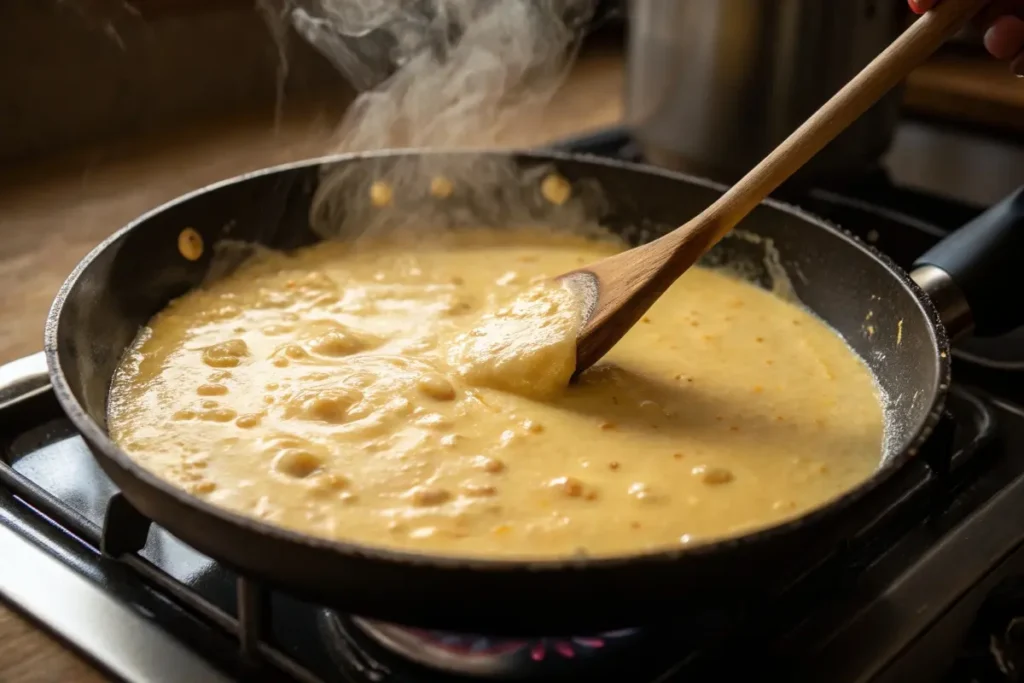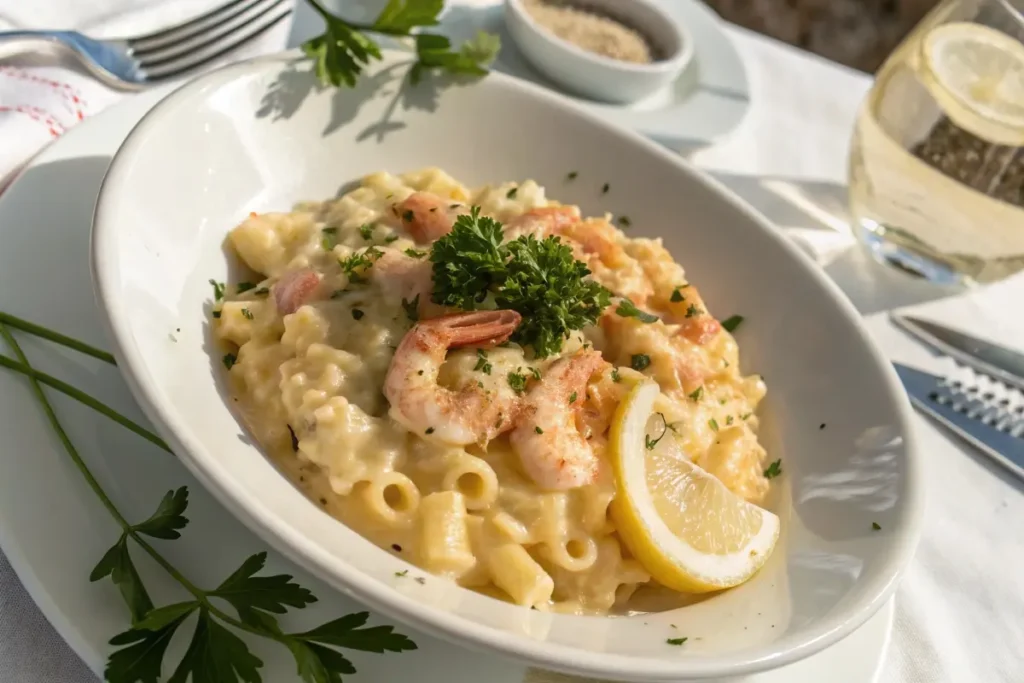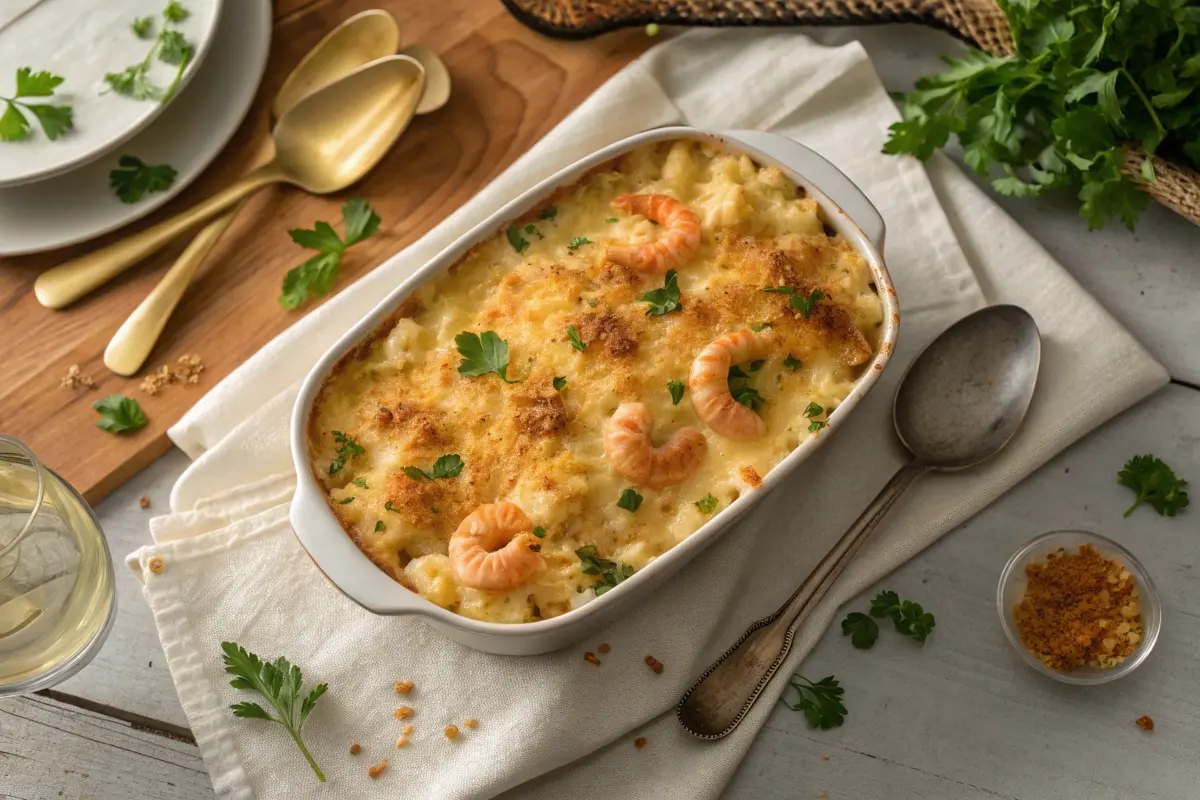Craving the ultimate comfort food with a luxurious twist? Look no further than this seafood mac and cheese recipe. Imagine creamy, cheesy pasta paired with the rich, briny flavor of seafood—it’s indulgence in every bite! Whether you’re hosting a dinner party or treating yourself to a cozy night in, this dish is guaranteed to impress. In this guide, we’ll walk you through everything you need to know, from selecting the best seafood and cheeses to troubleshooting common issues. Plus, we’ll explore exciting variations to help you customize the recipe to your taste. Let’s dive in!
Table of Contents
Why Seafood Mac and Cheese?
What Makes This Dish Unique?
Seafood mac and cheese is not your ordinary pasta dish. It’s a perfect fusion of creamy, cheesy comfort food with the delicate, savory flavors of seafood. The rich, velvety cheese sauce complements the sweetness of shrimp, the succulence of lobster, and the tender texture of crab meat. This combination elevates a simple mac and cheese recipe to a gourmet experience.
One of the best parts of this seafood mac and cheese recipe is its versatility. You can customize the dish based on the seafood you love or what’s available in your local market. From casual family dinners to holiday gatherings, this dish fits any occasion.
The Versatility of Seafood Mac and Cheese
What’s great about this dish is that it’s as flexible as it is delicious. You can swap ingredients to suit your dietary preferences or explore regional twists. Want to add a spicy kick? Try cajun spices! Looking for something indulgent? Use lobster tails or scallops.
This seafood mac and cheese recipe also pairs wonderfully with various sides, like garlic bread or steamed vegetables, making it a complete meal that satisfies every craving. No matter how you serve it, this dish always hits the spot.
Essential Ingredients for Seafood Mac and Cheese
Key Seafood Choices
The magic of any seafood mac and cheese recipe starts with choosing the right seafood. Shrimp, crab, lobster, and scallops are classic options that bring both flavor and texture to the dish.
- Shrimp: Versatile and easy to cook, shrimp add a slightly sweet, tender bite that pairs perfectly with creamy cheese. Opt for medium or large shrimp, peeled and deveined for convenience.
- Crab Meat: Whether you choose fresh lump crab meat or canned, it adds a rich, slightly sweet flavor to your mac and cheese. For an affordable twist, imitation crab can also work in a pinch.
- Lobster: The ultimate indulgence, lobster meat adds a decadent touch. Look for cooked lobster tails or claw meat for easy prep.
- Scallops: Small bay scallops or sliced sea scallops cook quickly and provide a delicate, buttery texture.
When selecting seafood, fresh is always best, but frozen options are a great backup. Just be sure to thaw frozen seafood properly before cooking to ensure the best texture and flavor.
The Cheese Blend
What makes this seafood mac and cheese recipe irresistible is the perfect blend of cheeses. Not all cheeses melt well, so choosing the right mix is crucial.
- Cheddar: Sharp cheddar is a must for its bold flavor and creamy melt.
- Gruyere: Adds a nutty richness that elevates the dish.
- Parmesan: A sprinkle of parmesan enhances the overall depth of flavor.
- Cream Cheese: Incorporating cream cheese ensures a velvety texture for the sauce.
Avoid pre-shredded cheese, as it often contains anti-caking agents that can affect the smoothness of your sauce. Freshly grated cheese is always the way to go.
Step-by-Step Instructions for Making Seafood Mac and Cheese
Prepping the Ingredients
Before you begin cooking, it’s important to prep your ingredients. Start by cleaning and prepping your seafood. For shrimp, remove the shells and devein them, then pat them dry to remove excess moisture. If you’re using crab or lobster, make sure the meat is free of shells and ready to cook.
Next, cook your pasta until it’s al dente—firm to the bite. Overcooked pasta can turn mushy when baked, so be sure to follow the package instructions. Drain the pasta and set it aside while you prepare the sauce.
Finally, grate all your cheeses. This step is key for creating a smooth, creamy sauce that coats every bite of pasta.
Making the Cheese Sauce

The cheese sauce is the heart of any great seafood mac and cheese recipe. Start by making a roux, which acts as the base of the sauce.
- Melt butter in a large saucepan over medium heat.
- Add all-purpose flour and whisk continuously for 1–2 minutes until golden and smooth.
- Slowly pour in warm milk, whisking constantly to avoid lumps. Let it simmer for a few minutes until it thickens.
Once the base is ready, lower the heat and gradually stir in your cheeses. Add a handful at a time, allowing each addition to melt completely before adding more. Season with salt, pepper, and optional spices like paprika or garlic powder for an extra kick.
Combining and Baking
Now it’s time to bring everything together. Gently fold the pasta into the cheese sauce, ensuring every piece is evenly coated. Add the seafood, stirring carefully to avoid breaking it apart.
Transfer the mixture to a greased baking dish and spread it out evenly. For an irresistible crunch, top the dish with breadcrumbs mixed with melted butter.
Bake in a preheated oven at 375°F (190°C) for 20–25 minutes, or until the top is golden brown and bubbling. Let it cool for a few minutes before serving, and get ready to dig into this rich and flavorful seafood mac and cheese recipe!
Variations and Customizations
Healthier Alternatives
While a seafood mac and cheese recipe is indulgent, there are simple ways to make it lighter without losing its comforting charm.
- Whole-Grain or Gluten-Free Pasta: Substitute regular pasta with whole-grain or gluten-free options for added fiber or to cater to dietary restrictions.
- Lighter Cheese Choices: Replace full-fat cheeses with reduced-fat versions. Greek yogurt or cottage cheese can also be blended into the sauce for creaminess with fewer calories.
- Seafood Substitutions: Opt for leaner seafood like white fish fillets or prawns instead of lobster or crab.
- Vegetable Boost: Add steamed broccoli, spinach, or peas to incorporate a serving of vegetables.
Small swaps can transform this decadent dish into something lighter yet still flavorful, perfect for weeknight dinners.
Regional Twists

This seafood mac and cheese recipe is a blank canvas for regional flavors. Here are a few fun ideas:
- Southern Cajun Style: Add cajun seasoning, diced andouille sausage, and extra shrimp for a spicy, bold twist.
- Italian-Inspired Version: Use garlic, parsley, and grated pecorino romano cheese for a Mediterranean flair.
- New England Lobster Style: Use only lobster meat, and add a hint of nutmeg and lemon zest to highlight the sweetness of the lobster.
Experimenting with flavors and spices lets you customize this dish to match your cravings or showcase local ingredients.
Troubleshooting Common Issues
Why Is My Cheese Sauce Gritty?
A gritty cheese sauce can be disappointing, but the good news is that it’s preventable. In a seafood mac and cheese recipe, the creamy texture of the sauce is essential, so let’s address the causes and solutions:
- Heat Control: High heat is often the culprit behind gritty sauces. When cheese is exposed to too much heat, its proteins and fats separate, creating a grainy texture. Always melt the cheese over low heat and stir constantly.
- Use Freshly Grated Cheese: Pre-shredded cheese contains additives like starch or cellulose, which can affect how smoothly it melts. Grate your cheese fresh for a perfectly creamy result.
- Gradual Addition of Cheese: Don’t dump all the cheese into the sauce at once. Instead, add it in small amounts and stir until each batch is fully melted before adding more.
If you’ve already ended up with a gritty sauce, don’t panic! Whisking in a tablespoon of heavy cream or adding a dollop of cream cheese can help smooth it out.
How Do I Avoid Overcooking the Seafood?
Overcooked seafood can ruin the texture of your dish, leaving it rubbery or dry. In a seafood mac and cheese recipe, keeping the seafood tender is just as important as nailing the sauce.
- Cook Seafood Separately: Sauté shrimp, scallops, or lobster briefly in a skillet before adding them to the mac and cheese. This ensures they’re perfectly cooked before mixing.
- Timing Matters: When baking the mac and cheese, fold in the cooked seafood just before transferring the mixture to the oven. The short baking time will heat the seafood without overcooking it.
- Watch the Oven Closely: Bake until the dish is golden and bubbling, but don’t exceed the recommended time.
For more tips on seafood preparation, check out this crab brulee recipe for inspiration.
Frequently Asked Questions
Can I Make Seafood Mac and Cheese Ahead of Time?
Yes, making this seafood mac and cheese recipe ahead of time is not only convenient but also helps the flavors meld together for an even tastier dish. To prep in advance, assemble the mac and cheese without baking. Cover the baking dish tightly with aluminum foil and refrigerate for up to 24 hours.
When you’re ready to serve, remove the dish from the fridge and let it sit at room temperature for 20–30 minutes. This step prevents uneven baking. Bake as instructed, adding 5–10 extra minutes to ensure the center is heated through.
What Are Good Side Dishes to Serve?
Pairing this seafood mac and cheese recipe with the right sides makes for a well-rounded meal. Here are a few suggestions:
- Roasted Vegetables: Oven-roasted asparagus or Brussels sprouts bring a fresh and earthy balance to the rich mac and cheese.
- Light Salads: A crisp green salad with a tangy vinaigrette cuts through the creaminess of the dish.
- Crusty Bread: A warm baguette or garlic bread is perfect for scooping up every cheesy bite.
Can I Freeze Seafood Mac and Cheese?
Absolutely! Freezing this seafood mac and cheese recipe is a fantastic way to save leftovers or prepare for future meals. For best results, assemble the dish but skip baking. Wrap the unbaked casserole tightly in foil and freeze for up to 3 months.
When ready to enjoy, thaw the dish overnight in the fridge. Bake as instructed, but add an extra 10–15 minutes to ensure it’s heated through. This method preserves the flavors and textures beautifully.hen ready to eat, thaw in the refrigerator overnight, then bake as instructed.

